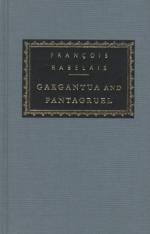Like Descartes and Balzac, he was a native of Touraine, and Tours and Chinon have only done their duty in each of them erecting in recent years a statue to his honour, a twofold homage reflecting credit both on the province and on the town. But the precise facts about his birth are nevertheless vague. Huet speaks of the village of Benais, near Bourgeuil, of whose vineyards Rabelais makes mention. As the little vineyard of La Deviniere, near Chinon, and familiar to all his readers, is supposed to have belonged to his father, Thomas Rabelais, some would have him born there. It is better to hold to the earlier general opinion that Chinon was his native town; Chinon, whose praises he sang with such heartiness and affection. There he might well have been born in the Lamproie house, which belonged to his father, who, to judge from this circumstance, must have been in easy circumstances, with the position of a well-to-do citizen. As La Lamproie in the seventeenth century was a hostelry, the father of Rabelais has been set down as an innkeeper. More probably he was an apothecary, which would fit in with the medical profession adopted by his son in after years. Rabelais had brothers, all older than himself. Perhaps because he was the youngest, his father destined him for the Church.
The time he spent while a child with the Benedictine monks at Seuille is uncertain. There he might have made the acquaintance of the prototype of his Friar John, a brother of the name of Buinart, afterwards Prior of Sermaize. He was longer at the Abbey of the Cordeliers at La Baumette, half a mile from Angers, where he became a novice. As the brothers Du Bellay, who were later his Maecenases, were then studying at the University of Angers, where it is certain he was not a student, it is doubtless from this youthful period that his acquaintance and alliance with them should date. Voluntarily, or induced by his family, Rabelais now embraced the ecclesiastical profession, and entered the monastery of the Franciscan Cordeliers at Fontenay-le-Comte, in Lower Poitou, which was honoured by his long sojourn at the vital period of his life when his powers were ripening. There it was he began to study and to think, and there also began his troubles.
In spite of the wide-spread ignorance among the monks of that age, the encyclopaedic movement of the Renaissance was attracting all the lofty minds. Rabelais threw himself into it with enthusiasm, and Latin antiquity was not enough for him. Greek, a study discountenanced by the Church, which looked on it as dangerous and tending to freethought and heresy, took possession of him. To it he owed the warm friendship of Pierre Amy and of the celebrated Guillaume Bude. In fact, the Greek letters of the latter are the best source of information concerning this period of Rabelais’ life. It was at Fontenay-le-Comte also that he became acquainted with the Brissons and the great jurist Andre Tiraqueau, whom he never mentions




